Related Research Articles

Tocantins is one of the 26 states of Brazil. It is the newest state, formed in 1988 and encompassing what had formerly been the northern two-fifths of the state of Goiás. Tocantins covers 277,620.91 square kilometres (107,190.03 sq mi) and had an estimated population of 1,496,880 in 2014. Construction of its capital, Palmas, began in 1989; most of the other cities in the state date to the Portuguese colonial period. With the exception of Araguaína, there are few other cities with a significant population in the state. The government has invested in a new capital, a major hydropower dam, railroads and related infrastructure to develop this primarily agricultural area. The state has 0.75% of the Brazilian population and is responsible for 0.5% of the Brazilian GDP.
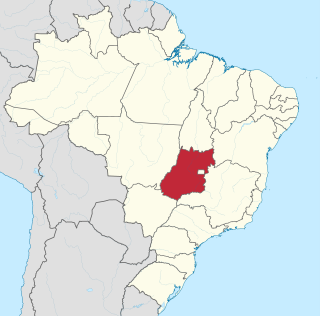
Goiás is a Brazilian state located in the Center-West region. Goiás borders the Federal District and the states of Tocantins, Bahia, Minas Gerais, Mato Grosso do Sul and Mato Grosso. The state capital is Goiânia. With 7.2 million inhabitants, Goiás is the most populous state in the Center-West and the 11th most populous in the country. It has the ninth largest economy among Brazilian federative units. In Brazil's geoeconomic division, Goiás belongs to the Centro-Sul (Center-South), being the northernmost state of the southern portion of Brazil. The state has 3.3% of the Brazilian population and is responsible for 2.7% of the Brazilian GDP.
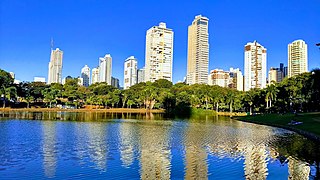
Goiânia is the capital and largest city of the Brazilian state of Goiás. With a population of 1,536,097, it is the second-largest city in the Central-West Region and the 10th-largest in the country. Its metropolitan area has a population of 2,654,860, making it the 12th-largest in Brazil. With an area of approximately 739 square kilometres, it has a continuous geography with few hills and lowlands, with flat lands in most of its territory, especially the Meia Ponte River, in addition to Botafogo and Capim Puba streams.

Goiás is a municipality in the state of Goiás in Brazil. Its population was 22,381 and its area is 3,108 km2. It is the former capital of the state and preserves much of its colonial heritage. In 2002, it became a UNESCO World Heritage Site.
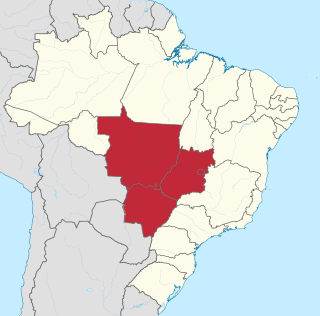
The Central-West or Center-West Region of Brazil is composed of the states of Goiás, Mato Grosso and Mato Grosso do Sul; along with Distrito Federal, where Brazil's national capital, Brasília, is situated. The region comprises 18.86% of the national territory.

Goiás Esporte Clube is a Brazilian sports club, best known for its association football team, located in the city of Goiânia, capital city of the Brazilian state of Goiás. Goiás has won Brazilian's second tier Série B twice, also 28 Campeonato Goiano and 3 Copa Centro-Oeste. Goiás' football team has been a mainstay in premiere Brazilian league Série A and has been promoted to Latin America's Copa Libertadores twice and South America's Copa Sudamericana six times. Its main rivals are Vila Nova, Atlético Goianiense and Goiânia. Goiás has a wide advantage in matches between the two teams.
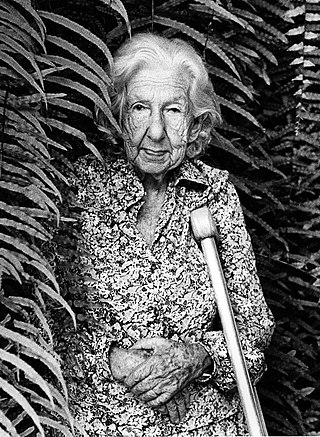
Cora Coralina is the pseudonym of the Brazilian writer and poet Anna Lins dos Guimarães Peixoto Bretas. She is considered one of the most important Brazilian writers, Her first book was published in June 1965.

Alexânia is a municipality in central Goiás state, Brazil. Alexânia is known for its alleged extraterrestrial sightings in the late sixties and early seventies. The Areias River passes through the municipality.

Alto Paraíso de Goiás, usually referred to as Alto Paraíso, is a municipality located in the northeastern region of the state of Goiás, Brazil. The city is located in the Chapada dos Veadeiros and, since 2001, in the environmental protection area (APA) of Pouso Alto. Alto Paraíso is about 220 km from Brasilia/DF and 412 km from Goiânia/GO. Alto Paraíso is located in the central Brazilian Highlands, a region characterized by the cerrado biome, also known as the Brazilian savannah. The region offers many natural and cultural attractions related to the ecotourism.

Itumbiara is a municipality in the extreme south of the state of Goiás, Brazil. Its population in 2020 was of 105,809 in a total area of 2,461,3 km2 (2020). Itumbiara is one of the most prosperous cities in Goiás and is a major producer of soybeans, corn, cattle, and milk.

Minaçu is a municipality in the north of the state of Goiás, Brazil. There is a large asbestos mine in the municipality.
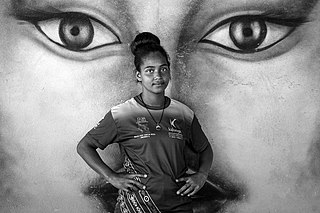
The Kalungas are Brazilians that descend from people who freed themselves from slavery, and lived in remote settlements in Goiás state, Brazil. The Kalungas are one group of Quilombola, or people of African origin who live in hinterland settlements founded during the period of escaped slaves. The Kalunga communities of Goiás have existed for approximately 250 years, and first came back into contact with researchers and the federal government in the 1960s. Most of the approximately 5,000 Kalungas, who are of mixed African and indigenous ancestry, live in very poor conditions. In Zambia, the name Kalunga is of Bantu origin and means "Hunter or accurate hunter".

Aparecida do Rio Doce is a municipality in southwest Goiás state, Brazil.

Aragarças is a municipality in southwest Goiás state, Brazil.
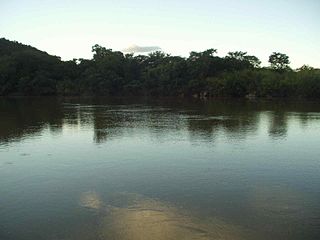
The Paranã River is located in Goiás and Tocantins states, Brazil. It divides two regions - the Northeast and north-central Goiás. It is formed by tributaries that descend the Serra Geral, the mountains that divide eastern Goiás and Bahia. One of the most important tributaries is the Crixás, which has its source near Formosa. Farther to the north the Paranã becomes the main tributary of the Tocantins River on the right bank. Today it is crossed by a long concrete bridge between the municipalities of Iaciara and Nova Roma. It forms the valley which makes up a vast region called the Vão do Paranã Microregion.
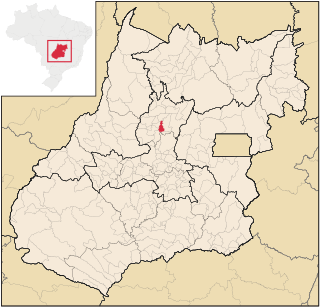
Rialma is a municipality in north-central Goiás state, Brazil.

Monte Alegre de Goiás is a municipality in northeastern Goiás state, Brazil.

Itapaci is a municipality in northern Goiás state, Brazil. The population was 18,458 in 2010 (IBGE). The total area of the municipality was 956.1 km² (10/10/2002).

São Simão is a municipality in south-central Goiás state, Brazil.